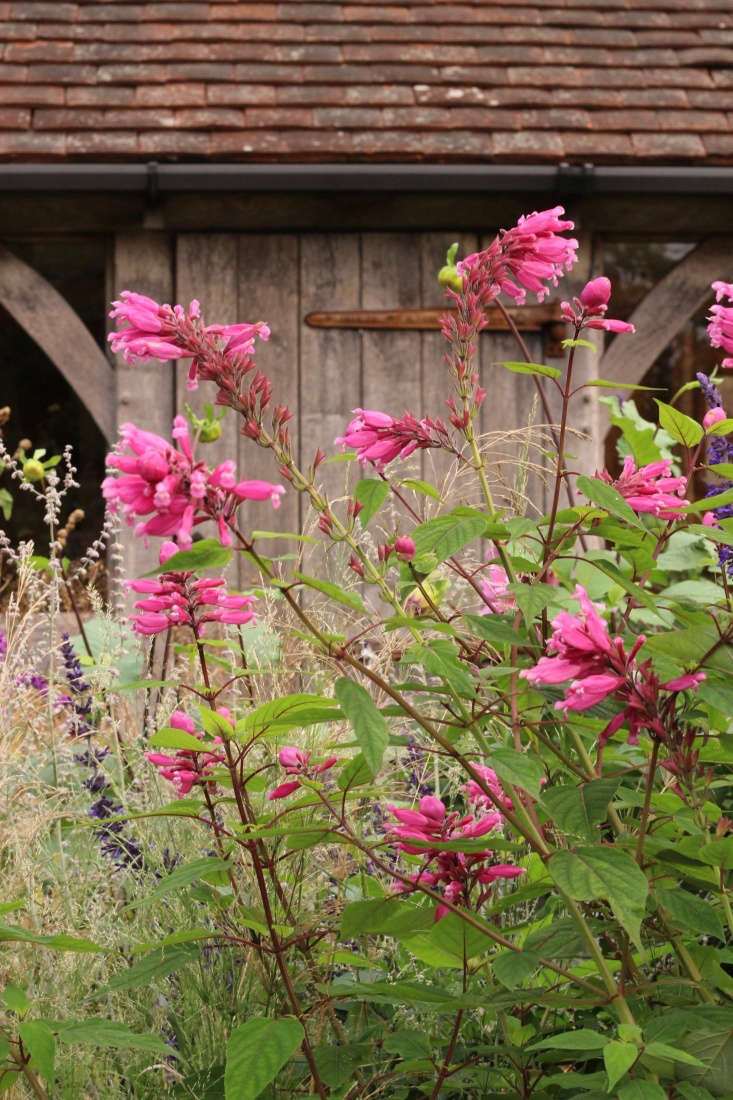Long-blooming salvias are saviors in the autumn garden. So when Gravetye Manor’s head gardener Tom Coward met me in a pair of shorts in October, I might have twigged to the semi-tropical splendor in store for me in Sussex (an hour’s train ride away from London). A second before, I’d stepped out of a 16th-century manor into a low-angled ray of golden sun. Backlit magenta dahlias glowed from the borders and a hot pink haze of salvia surrounded them.
I’d raced to make it to Gravetye before dark, so I barely had dropped my bags and grabbed my notebook before Tom found me blinking, agog, shamefully stumped at the genus level in 40 seconds flat: “What salvia…?”
Here’s a cheat sheet I compiled—with suggestions from both Gravetye and Dyson’s Nursery at the Great Comp Garden in Kent—to help you choose the right Salvia (commonly known as ornamental sage), a warm-climate perennial and a fast-growing annual in colder growing zones, to add color to a late-season border:
Photography by Christin Geall.
Salvia Curviflora

While Tom spoke, I jotted down a list of salvias to plant for late-season color in a border, starting with the cerise wonder I’d swooned over walking out of the manor’s heavy oak door: Salvia curviflora, with a lipstick-perfect trout pout.

A native of Mexico, Salvia curviflora has a dramatically curved flower and is a perennial in USDA zones 8 to 11.
Salvia Leucantha

Commonly known as Mexican bush sage, Salvia Leucantha establishes quickly; a shrub quickly will grow to a height and diameter of 5 feet.

Salvia Confertiflora

In other borders, Salvia confertiflora towered above tall Tagetes (French marigolds) and the crimson Dahlia ‘Dove Grove’. The confertiflora is a tender but spectacular plant, growing to a height of more than 5 feet in a season.
Coward uses salvias to provide late-season interest in the borders. Their rich colors play well with other strong autumn colors: deep yellows, oranges, and pinks. Their forms, from upright sub-shrubs to smaller edging plants, extend their versatility.
Salvia ‘Phyllis’ Fancy’

Named to honor a long-time volunteer at the University of California’s Santa Cruz Arboretum, Salvia ‘Phyllis’ Fancy’ was discovered on the California coast. Probably a cross of Salvia leucantha and Salvia chiapensis, ‘Phyllis Fancy’ flowers are a strong lure for pollinator insects and hummingbirds.
Salvia Involucrata


Growing tips from our recent post Gardening 101: Salvias: “Salvias thrive in arid conditions, appreciating free-draining soil,” writes Kendra.
“With regular deadheading, they can flower from late spring until the first frosts.”

To learn more, I headed to Dyson’s Nursery at the Great Comp Garden in Kent, which specializes in salvias. There, in the hazy mists of autumn, I was struck again at how the singe of salvias cheers.
Salvia ‘Ember’s Wish’

The Salvia genus contains more than 900 species. The species and cultivars of interest to gardeners (for their long-flowering period and color) generally hail from the southern US, Mexico, and through Central America into Brazil. As such, they are generally tender or half-hardy and require winter protection.
Salvia ‘Love and Wishes’

N.B.: See more ideas to extend the flowering season well into autumn:
- Salvia: A Field Guide to Planting, Care, and Design.
- The Ultimate UK Getaway: 1 Hour From London, But a World Away at Gravetye Manor.
- Color Theory: 10 Perfect Plant Combinations for Autumn.
Finally, get more ideas on how to successfully plant, grow, and care for salvia with our Salvia: A Field Guide.
Finally, get more ideas on how to plant, grow, and care for various perennial plants with our Perennials: A Field Guide.








Have a Question or Comment About This Post?
Join the conversation